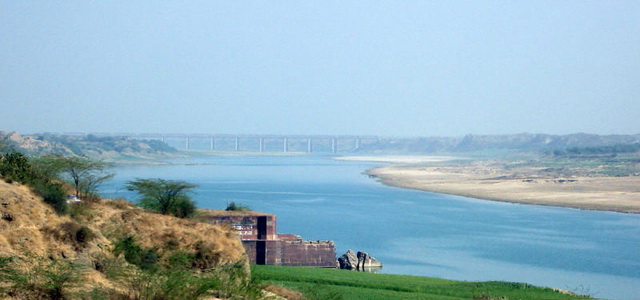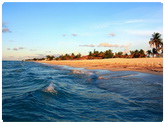| Quick Facts: | Chambal River |
|---|---|
| Countries: | Madhya Pradesh Rajasthan and Uttar Pradesh |
| Source: | Janapao Hills Vindhya Range |
| Length: | 885 km (550 miles) |
| Mouth: | Yamuna River |
| Tributaries: | Banas; Mej; Parbati; Kali; Sindh & Shipra |
Location and General Information on the Chambal River
The Chambal River is located in northern India and flows through three Indian states: Madhya Pradesh, Rajasthan and Uttar Pradesh. The Chambal also forms part of the Rajasthan-Madhya Pradesh boundary.
About 885 km (550 miles) long, it rises in the old Vindhya Range and flows in northeastern direction. There, it becomes the second biggest tributary of the Yamuna River, which is the largest tributary of the Ganges.
The Chambal River’s passage across the Madhya Bharat Patar plateau is marked by a series of gorges and by the Chambal ravine system below its junction with the Banas River.
The main tributaries of Chambal include the Banas and Mej rivers on the left and the Parbati, Kali Sindh and Shipra rivers on the right.
Economic importance
From an economical point of view, the Chambal River is very important to India as it houses four dams. The oldest of these, the Gandhi Sagar is located at the entrance of the Kanjarda Plateau. This dam has five generators, each of them producing 23 MW of energy. Another dam, near Kota, was started in 1952 as part of India’s first 5-year plan. The third dam, the Jawahar Sagar dam was the third to be built on Chambal, and the last dam is the Rana Pratap Sagar Dam.
Chambal River as a Tourist Attraction
The Chambal River was relatively pollution free, especially when compared to other Indian rivers. In 1979 the National Chambal Sanctuary was set up. The sanctuary is 425 km long, and 2-6 km wide. It is a place where eco-tourism is widely practiced, and the site is excellent for bird watching or crocodile watching. However, in recent years the human pollution has made its way into the river, threatening the eco system that thrived with little human interaction. Unfortunately, factory and farming runoff as well as garbage are starting to affect the region.
The Chambal River also crosses some interesting cities to visit, like Kota, Rajeshtan, but it is mainly recommended for eco-tourists.





